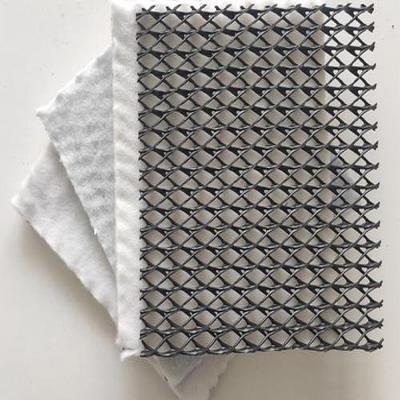1. Preparation before construction
1、Design Review and Material Preparation
Before construction, the design scheme of the composite drainage network should be reviewed in detail to ensure that the scheme meets the engineering requirements and specification requirements. According to the design requirements and engineering quantities, purchase an appropriate amount of composite drainage network, select it according to the engineering requirements and waterproofing grade requirements, and check its quality certification documents and appearance quality to ensure that it meets the requirements.
2、Site clearing and grass-roots treatment
Want to Clean up debris, accumulated water, etc. in the construction area to ensure that the working surface is smooth and dry. When treating the base layer, it is necessary to remove the floating ash, oil and other impurities on the surface, repair and smooth, and the flatness requirement is not more than 15% mm, The compaction degree should meet the design requirements. Make sure the base layer is firm, dry, and clean. Also check whether there are hard protrusions such as gravel and stones on the base layer, and remove them in time if so.
2. Construction method of composite drainage network
1、Determine the location and datum line
According to the design requirements, the laying position and shape of the composite drainage net are marked on the foundation. Determine the baseline location.
2、Laying composite drainage network
Lay the composite drainage net flat on the baseline to ensure that the net surface is smooth and wrinkle-free. For projects with overlap requirements, overlap treatment should be carried out according to the design requirements, and the length and method of overlap should conform to the specifications. During the laying process, you can use a rubber hammer to gently tap the mesh surface to make it closely bond with the base layer.
3、Fixed composite drainage network
Use appropriate fixing methods to fix the composite drainage net on the base layer to prevent it from shifting or sliding. Commonly used fixing methods include nail shooting, layering, etc. When fixing, be careful not to damage the mesh surface, and ensure that the fixing is firm and reliable.
4、Connection and closure processing
The parts that need to be connected, such as the joints of the drainage net, should be connected with special connectors or adhesives to ensure firm connections and good sealing. The closing part is carefully treated to ensure the appearance quality and waterproof performance.
5、Sand filling and backfilling soil
Fill an appropriate amount of sand at the joint of the composite drainage net and the drainage pipe to protect the drainage net and joint from damage. Then carry out the backfill operation, spread the required filler evenly in the excavation, and pay attention to layered compaction to ensure tight fill. When backfilling soil, it is necessary to avoid damage to the composite drainage network.
6、Facility installation and drainage treatment
Install corresponding drainage pipes, maintenance wells, valves and other facilities according to the actual situation to ensure smooth drainage of the whole project. Also check whether the drainage system is operating properly to ensure that there is no water leakage.

3. Construction precautions
1、Construction environment control
During the construction process, keep the base dry and clean, and avoid construction in rainy or windy weather. Care should also be taken to prevent mechanical damage or man-made damage to the base layer.
2、Material Protection
During transportation and construction, attention should be paid to protecting the composite drainage net to avoid it being damaged or contaminated. It should also be stored and kept according to the requirements of the specification.
3、Quality inspection and acceptance
After the construction is completed, the laying quality of the composite drainage network should be tested to ensure that it meets the design requirements and relevant standards. Unqualified parts should be rectified in time. It is also necessary to carry out completion acceptance, check all quality points one by one, and make records.
It can be seen from the above that the composite drainage network is an important material in engineering construction, and its construction method plays an important role in ensuring the quality of the project.
Post time: Mar-15-2025



